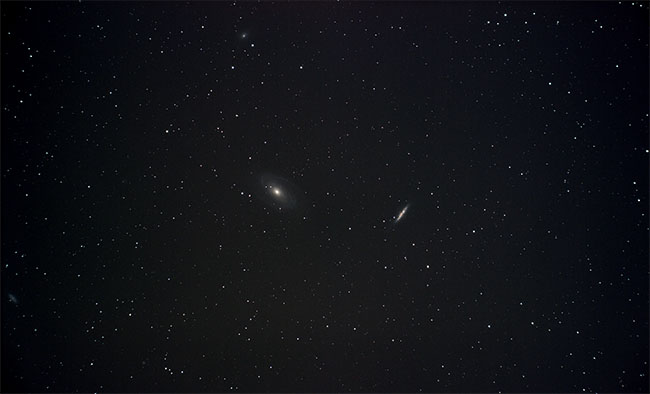M81 & M82
 It was over three months that me and Leif were out to do some astrophotography since the weather has been really awful. As a last desperate try, we went out on a Tuesday despite having go to work the day after (though coming a bit later than usual!). Despite the weather forecast not looking too bright the clouds dissipated and the stars came out to show themselves! This was the first time we autoguided both our telescopes (Meade LX200-GPS and APO on a Skywatcher NEQ6 Pro) with two separate autoguiding cameras (QHY5l-II and QHY5-II) but from the same computer. Everything worked FLAWLESSLY the whole night. We could basically just press "GOTO" for an object and then let the guidesystem do all the work while we went inside the house and talking astronomy :)
It was over three months that me and Leif were out to do some astrophotography since the weather has been really awful. As a last desperate try, we went out on a Tuesday despite having go to work the day after (though coming a bit later than usual!). Despite the weather forecast not looking too bright the clouds dissipated and the stars came out to show themselves! This was the first time we autoguided both our telescopes (Meade LX200-GPS and APO on a Skywatcher NEQ6 Pro) with two separate autoguiding cameras (QHY5l-II and QHY5-II) but from the same computer. Everything worked FLAWLESSLY the whole night. We could basically just press "GOTO" for an object and then let the guidesystem do all the work while we went inside the house and talking astronomy :)
This is M81 & M82, and the nice thing is that one of the stars in M82 went supernova a couple of weeks ago, and this supernova is still visible in this picture! In this image there are also some other galaxies visible, as NGC3077 as a faint fuzzy blob above M81. 
 A galaxy is a massive, gravitationally bound system consisting of stars, stellar remnants, an interstellar medium of gas and dust, and dark matter. Examples of galaxies range from dwarfs with as few as ten million stars to giants with one hundred trillion stars, each orbiting their galaxy's own center of mass.
A galaxy is a massive, gravitationally bound system consisting of stars, stellar remnants, an interstellar medium of gas and dust, and dark matter. Examples of galaxies range from dwarfs with as few as ten million stars to giants with one hundred trillion stars, each orbiting their galaxy's own center of mass. ― source and more information wikipedia
― source and more information wikipedia
Date: 2014-02-26 / 01:06:00 UTC
Location: Ekerö, Sweden
Temperature: 2 °C
Telescope: William-Optics Megrez 88FD
Camera: Canon 600D
ISO: 800
Mount: Skywatcher NEQ6 Pro Synscan
Exposure time: 57 X 60 sec
Reducer/flattener: William-Optics 0.8X reducer/flattener (P-FLAT-F6)
Other info: Autoguided with 50mm guidescope and QHY5-II. Used PHD2 (2.2.1) guiding software.
Processing: Stacked and darks-subtracted in DeepSkyStacker. Processed in Photoshop CS6.




 2014-02-26
2014-02-26 